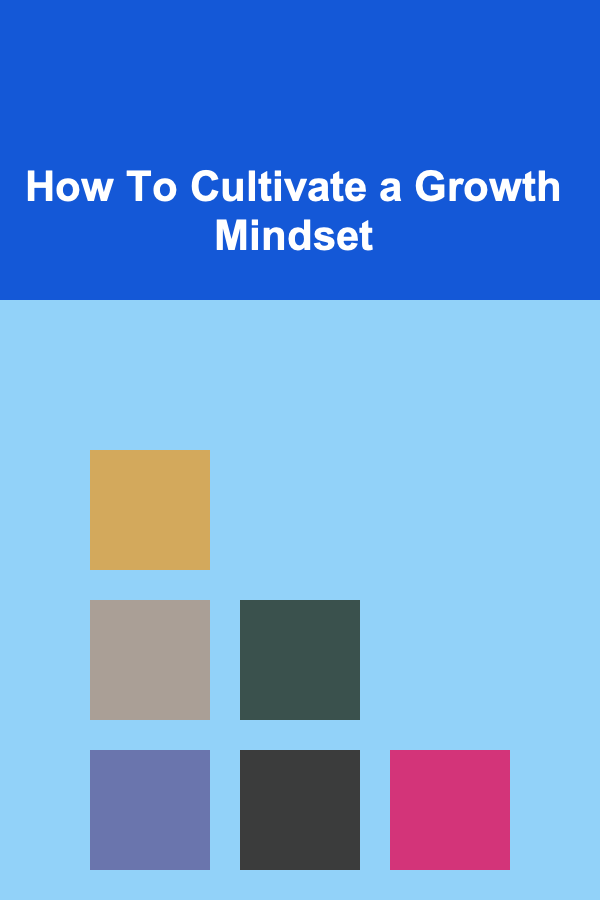
How To Cultivate a Growth Mindset
ebook include PDF & Audio bundle (Micro Guide)
$12.99$6.99
Limited Time Offer! Order within the next:

In recent years, the concept of the growth mindset has become increasingly popular in educational and professional contexts. Coined by psychologist Carol Dweck, the growth mindset is the belief that abilities and intelligence can be developed through dedication, effort, and learning, rather than being fixed traits. This mindset contrasts with the fixed mindset, which holds that abilities are innate and unchangeable. A growth mindset can lead to greater resilience, improved problem-solving, and a more productive and fulfilling life. But how does one cultivate this mindset? In this article, we will delve into practical strategies and psychological principles to help individuals embrace and nurture a growth mindset.
Understanding the Growth Mindset
To cultivate a growth mindset, it's essential to first understand what it is and why it matters. The growth mindset is based on the idea that learning and intelligence are dynamic. People with a growth mindset tend to view challenges as opportunities to improve, believe effort leads to success, and embrace the process of learning.
On the contrary, those with a fixed mindset believe that abilities are static and unchangeable. They often shy away from challenges, fear failure, and may avoid effort, believing that if they were truly capable, things would come easily to them.
Key Characteristics of a Growth Mindset:
- Embrace Challenges: People with a growth mindset see challenges as opportunities to learn and grow.
- Perseverance: They understand that effort and persistence are essential for success.
- Learning from Criticism: Constructive feedback is seen as a valuable tool for improvement, rather than a personal attack.
- Celebrate Others' Successes: Instead of feeling threatened by the success of others, those with a growth mindset celebrate and learn from it.
Key Characteristics of a Fixed Mindset:
- Avoidance of Challenges: Fear of failure leads to avoiding difficult tasks.
- Effort is Futile: People with a fixed mindset may feel that if something is hard, they aren't capable of doing it.
- Defensiveness to Feedback: Negative feedback can be seen as an attack, leading to a defensive or dismissive response.
- Envy of Others' Success: Rather than celebrating others' successes, individuals with a fixed mindset may feel threatened or envious.
Recognizing the distinction between a fixed and growth mindset is the first step in cultivating a mindset that fosters growth and resilience.
Cultivating a Growth Mindset: Practical Strategies
Now that we understand the basics of a growth mindset, let's look at actionable strategies to cultivate and reinforce this mindset.
2.1. Embrace Challenges
A critical aspect of developing a growth mindset is learning to embrace challenges instead of avoiding them. The fear of failure often keeps people from stepping out of their comfort zones. However, challenges are where growth happens. When you push yourself into unfamiliar or difficult situations, you gain new experiences and learn more about your abilities.
How to Embrace Challenges:
- Shift your perspective: Instead of viewing challenges as obstacles, see them as opportunities for growth.
- Start small: Begin with manageable challenges that push your boundaries and gradually work up to more significant challenges.
- Track your progress: Keeping a journal of your challenges and what you've learned from them can help you see your development over time.
For example, if you're learning a new language, it may seem daunting at first. But by embracing the challenge, acknowledging that mistakes are part of the learning process, and continuing to practice, you gradually improve and gain more confidence in your abilities.
2.2. Redefine Failure
In a growth mindset, failure is not something to fear or avoid but a necessary part of the learning process. Everyone experiences failure; the difference lies in how we respond to it. People with a growth mindset view failure as a stepping stone to success, while those with a fixed mindset see it as a reflection of their inadequacy.
How to Redefine Failure:
- See failure as a lesson: After a setback, reflect on what went wrong, what you can learn from it, and how you can improve next time.
- Avoid self-blame: Instead of telling yourself that you are "not good enough," recognize that effort and perseverance can lead to improvement.
- Learn from others: Seek out stories of others who have failed and bounced back. Understanding that even highly successful people have faced failure can help you feel more resilient.
For instance, Thomas Edison famously failed thousands of times before inventing the lightbulb. However, he viewed each failure as a lesson, saying, "I have not failed. I've just found 10,000 ways that won't work." Emulating this mindset helps you move forward rather than getting stuck in self-doubt.
2.3. Develop a "Yet" Attitude
One of the simplest yet most powerful tools to cultivate a growth mindset is to add the word "yet" to your self-talk. Instead of saying, "I can't do this," say, "I can't do this yet." This simple shift in language reinforces the belief that growth is possible and that you are capable of improvement over time.
How to Use the "Yet" Technique:
- Incorporate "yet" into your thinking: When you encounter a challenge or struggle, remind yourself that you may not have mastered it yet, but with effort, you can improve.
- Use it for self-affirmation: Write down areas where you're struggling and frame them in terms of "yet." For example, "I haven't mastered coding yet" or "I haven't run a marathon yet."
- Focus on progress: Reflect on how much you've already improved, even if you haven't achieved the ultimate goal.
By using "yet," you acknowledge that success is not about immediate perfection but about the journey of continuous improvement.
2.4. Seek Constructive Feedback
Feedback is one of the most powerful tools for growth. However, people with a fixed mindset may shy away from feedback because they see it as a criticism of their abilities. Conversely, those with a growth mindset embrace feedback as a tool for improvement and learning.
How to Seek and Use Feedback Effectively:
- Be open to feedback: Actively seek feedback from colleagues, mentors, or friends. Let them know that you are open to suggestions for improvement.
- Focus on the process, not the person: When receiving feedback, focus on the actions and behaviors that can be improved rather than interpreting it as a judgment of your character.
- Take action on feedback: Implement the suggestions you receive and use them to improve your performance. Reflect on how the feedback helps you move closer to your goals.
Feedback helps to shine a light on areas where you can improve. For example, if you're working on public speaking, asking for feedback on how to improve your delivery or tone can be extremely valuable. The more you embrace feedback, the more you can evolve.
2.5. Cultivate Resilience Through Effort
Effort is a core principle of the growth mindset. Those with a fixed mindset believe that talent alone is the key to success, but growth-minded individuals understand that effort, practice, and perseverance are essential. Cultivating resilience is about learning to persist even in the face of setbacks.
How to Build Resilience:
- Practice regularly: Whether it's learning a new skill, building a habit, or improving a relationship, consistent effort over time leads to progress.
- Understand that growth is incremental: Not all progress will be dramatic. Acknowledge the small wins, as each step forward contributes to long-term growth.
- Stay persistent: When challenges arise, keep going. Remember that resilience is built by facing adversity, not by avoiding it.
Building resilience can be particularly important in professional settings. For instance, entrepreneurs often face numerous setbacks, but those with a growth mindset are more likely to persevere and innovate, rather than giving up.
2.6. Reframe Your Self-Talk
Our inner dialogue plays a powerful role in shaping our mindset. People with a fixed mindset often engage in negative self-talk, such as "I'm not good enough" or "I'll never be successful." Reframing this negative self-talk can help foster a growth mindset.
How to Reframe Self-Talk:
- Catch negative thoughts: Become aware of moments when you're engaging in self-criticism or doubt.
- Challenge limiting beliefs: Ask yourself whether the belief you hold is based on evidence or assumptions. Replace it with a more empowering thought.
- Practice affirmations: Develop a list of positive affirmations that reinforce your ability to grow and learn. For example, "I am capable of improving through effort."
This technique can be incredibly powerful. When faced with challenges, reframe your thoughts from "This is too hard for me" to "This may be hard now, but I can improve with practice."
The Role of Environment in Cultivating a Growth Mindset
Your environment, including the people around you, plays a critical role in shaping your mindset. A supportive, growth-oriented environment can make it easier to adopt a growth mindset, while a fixed mindset culture may reinforce limiting beliefs.
How to Create a Growth-Oriented Environment:
- Surround yourself with growth-minded individuals: Being around people who embrace challenges and view failure as a learning opportunity can inspire and motivate you to do the same.
- Foster a culture of growth: If you're in a leadership position, create an environment where mistakes are seen as learning opportunities and feedback is welcomed.
- Avoid fixed mindset influences: Try to limit exposure to people or environments that emphasize talent over effort or that discourage taking risks.
An environment that values learning and growth will naturally support the development of a growth mindset.
Conclusion
Cultivating a growth mindset is a lifelong journey that requires continuous effort and practice. By embracing challenges, reframing failure, adopting a "yet" attitude, seeking constructive feedback, and cultivating resilience, you can gradually shift your mindset from fixed to growth-oriented. Remember that growth is a process, not an end goal, and every small effort contributes to your overall development.
The benefits of a growth mindset are far-reaching. It enables you to overcome setbacks, tackle new challenges, and reach your full potential in every area of your life. Whether in your career, personal life, or creative endeavors, adopting a growth mindset can make all the difference in your ability to succeed and thrive.

How to Choose Quality Over Quantity in Everyday Items
Read More
How to Create a Smart School Supply Station for Kids
Read More
How to Diversify Your Portfolio with International Real Estate
Read More
How to Find and Keep Seasonal Clothing Essentials
Read More
How To Master Storytelling for Business Presentations
Read More
Animating for Virtual Reality: A Deep Dive
Read MoreOther Products

How to Choose Quality Over Quantity in Everyday Items
Read More
How to Create a Smart School Supply Station for Kids
Read More
How to Diversify Your Portfolio with International Real Estate
Read More
How to Find and Keep Seasonal Clothing Essentials
Read More
How To Master Storytelling for Business Presentations
Read More